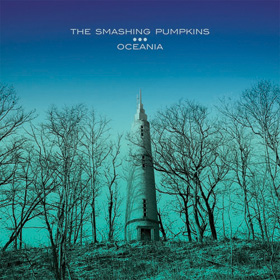Oceania by The Smashing Pumpkins

4.5/5
They are a band whose music floated through a world full of flannel shirts, Furbies and Full House—when an evolution from 80s glam metal to 90s grunge was defining the start of a new decade. With a distinct MO that allowed them to transcend a general categorization in the “alternative rock movement,” The Smashing Pumpkins, while an integral part of the decade’s culture, was not confined by it.
No matter what stage of life Pumpkins’ fans found themselves in at the height of the band’s 90s popularity, listening to their music now inspires an unmistakable nostalgia—a time machine to the past. However, on the flip side of a six-year hiatus, The Smashing Pumpkins continue to evolve
With Billy Corgan fronting the band since it started in 1988 in Chicago, Ill., The Smashing experienced a host of mainstream successes with Siamese Dream in 1993, Mellon Collie and the Infinite Sadness in 1995, a band breakup in 2000 and an ever-rotating cast of instrumental characters. Now, with Corgan and three completely new members, the Pumpkins have released their ninth studio album Oceania, and Corgan’s imperious influence is evident in the same stirring auditory art of decades ago.
On Oceania, the Pumpkins are revising rather than reinventing. Corgan’s distinct vocals ground the songs, while the densely layered instruments push the band to a previously unheard musical state. The band still manages to produce a noise that is simultaneously dreamlike and tangible. The push and pull between fantasy and reality allows the music to concoct enough emotion to speak for itself.
The album’s lead track “Quasar” introduces the listener to Corgan’s speculative world and appropriately feels like the start of a journey into an introspective state of mind. Its fast-paced, guitar-laden melodies are reminiscent of hit tracks such as Siamese Dream’s “Cherub Rock.” Similarly, a repeating guitar part on “Inkless” mirrors “Hummer” off the same 1993 album.
With “The Celestials,” the tempo slows, aided by a violin and vocal support from bassist Nicole Fiorentino, a softer-edged sound. Corgan has always been known for his cathartic lyrics. Evident here is the tension between hard rock and sensitivity when Corgan sings, “Till the end, I’m going to love you, 101 percent.” While some may deem them as trite, the musical backbone causes the words to connect with the listeners on an empathetic level. One of the best things about the album is the noticeable distinction between reflective moments and unabashed energy.
“One Diamond, One Heart” displays the band’s instrumental versatility with a mix of psychedelic, grunge, heavy metal and electronica. While on Oceania and other recent albums the Pumpkins utilize newer musical technology by incorporating more electronic sounds onto the tracks, many songs on the album, such as “My Love is Winter,” could have just as easily fit in on albums like Mellon Collie and Adore (1998). These songs are not out of step with the contemporary music scene but are indicative that the Pumpkins have fashioned something timeless.
“Pinwheels,” epitomizes the tension between otherworldly, electronic noises and very prominent guitar. Corgan and Fiorentino declare “Mother Moon, Mistress of the Sun, Say I got you, I got you,” and then resumes with “You don’t deserve me, but I deserve you.” It is these quiet moments that make you want to hear Corgan’s story.
The pace picks back up on track 10, “The Chimera.” Corgan proclaims, “If I’m wrong, I’m right, I’m never going to lose you.” Love is not a new topic for Corgan, but this is tamer compared to themes of suicide and drugs in past tracks like “Today” and “Try, Try, Try.” “Wildflower” fittingly draws the 13-track long journey to a close, as its wistful melody indicates an impending end.
Oceania combines the instrumental and vocal consistency of the past with positive revisions that work in 2012. The album is less confrontational than others, but after nearly twenty years of evolution, a slower pace is to be expected. Ultimately, Corgan stays true to himself, and Oceania allows fans to harness a new nostalgia. The beauty of its auditory excursion makes the listener’s personal experiences both meaningful and emotional.
Release Date: June 19, 2012
Label: Martha's Music
Stars: 4.5 out of 5
RELATED ARTICLES
Get the most-revealing celebrity conversations with the uInterview podcast!







Leave a comment